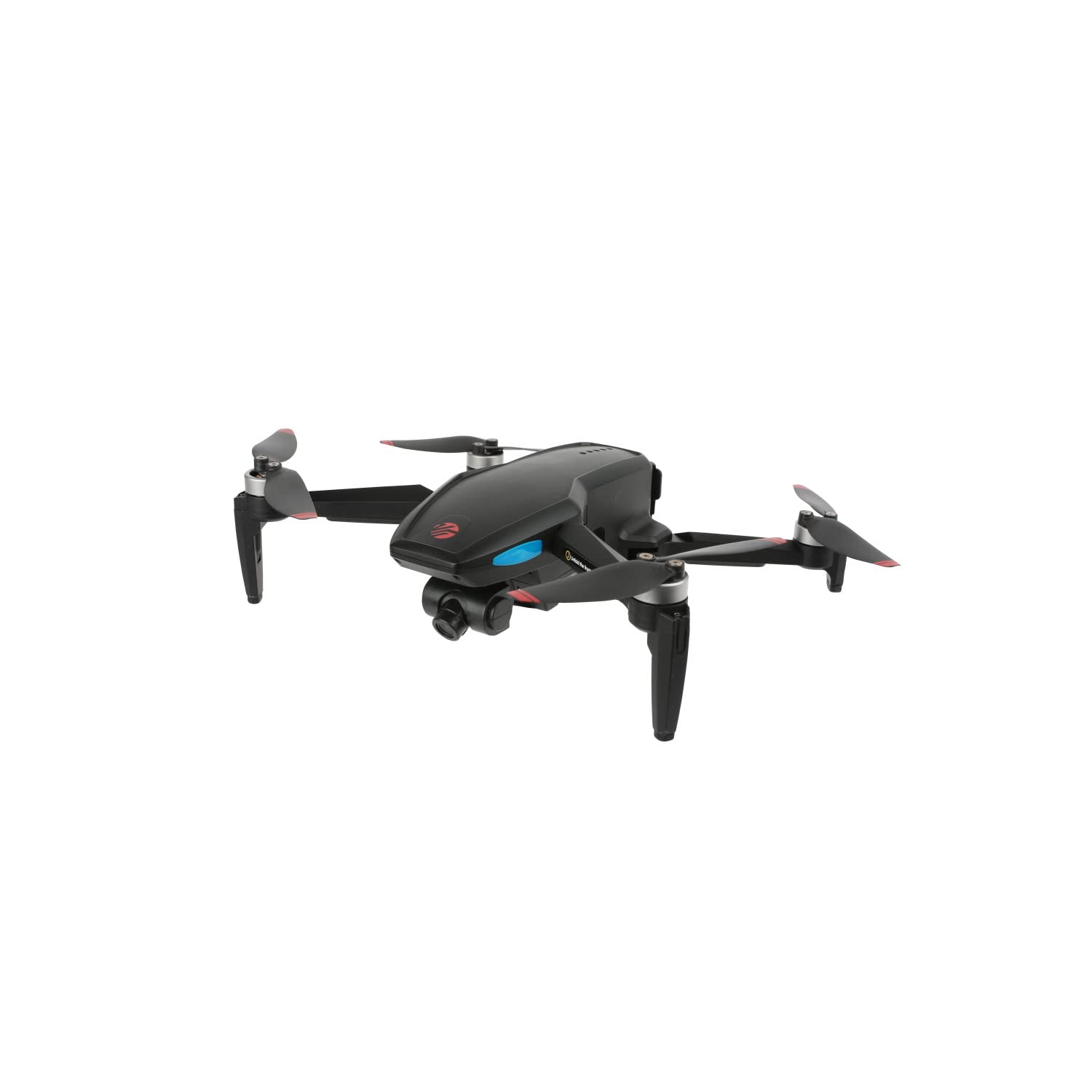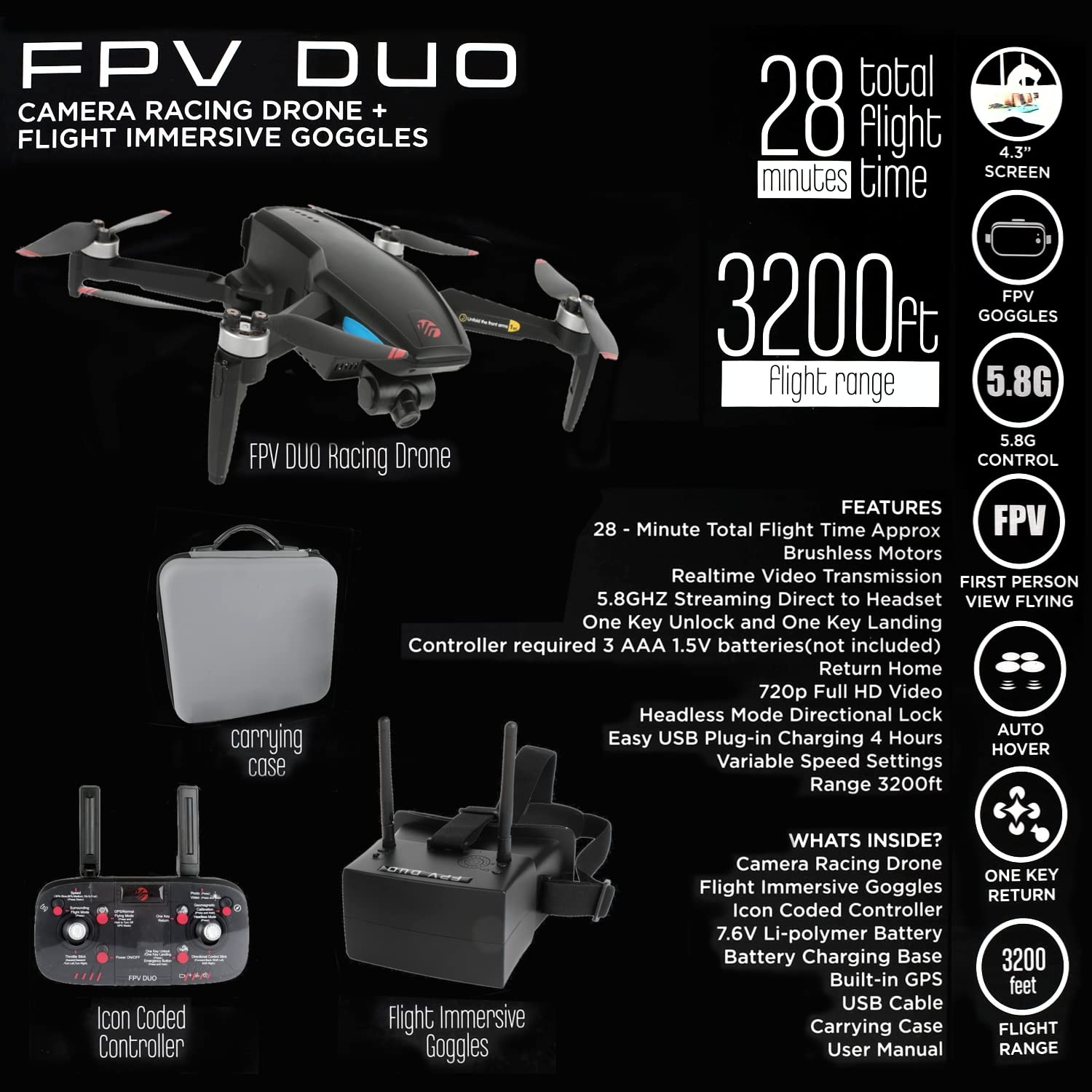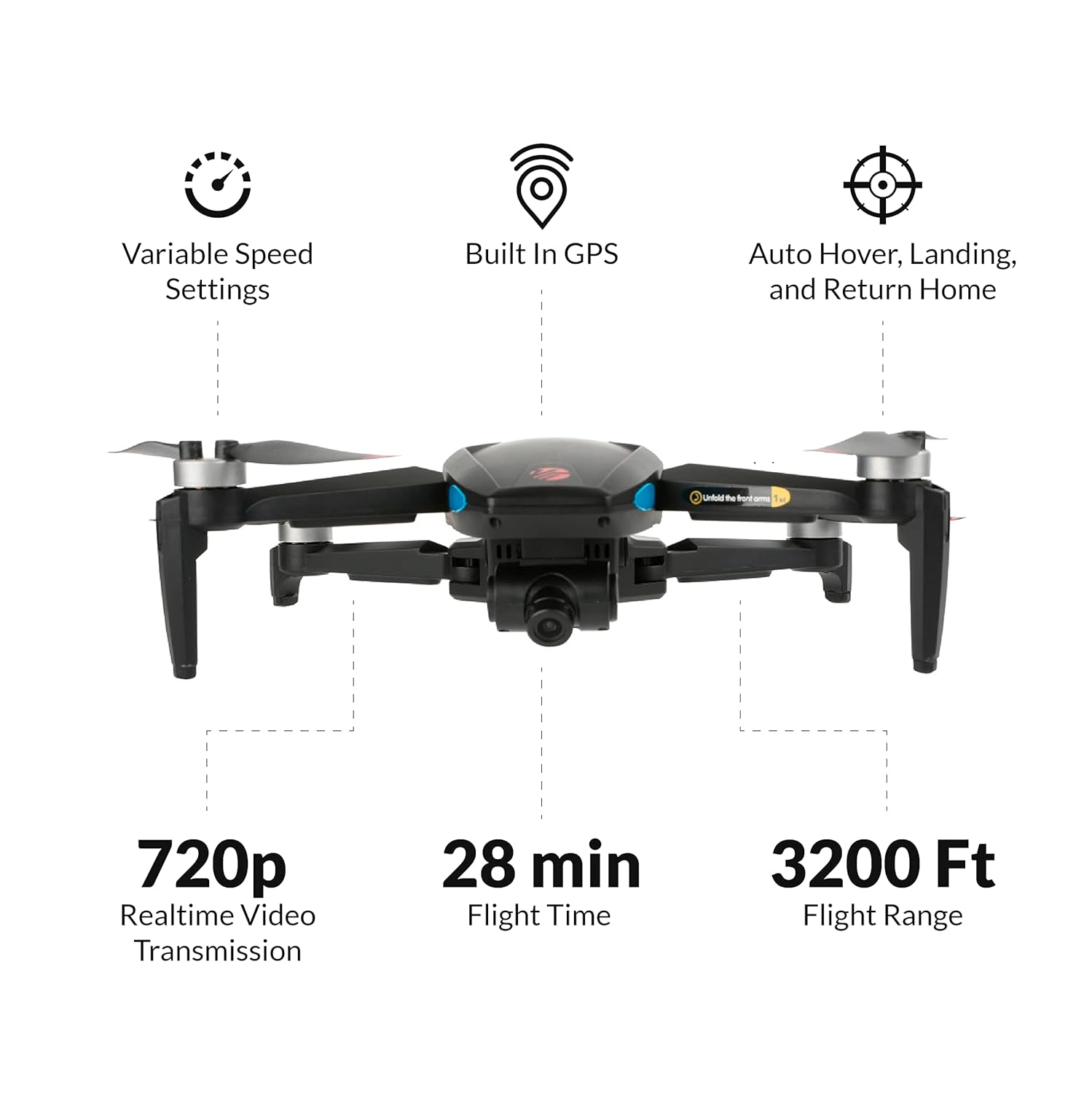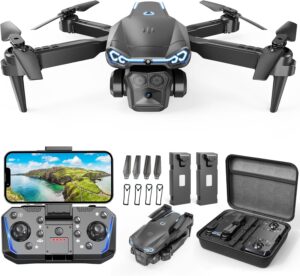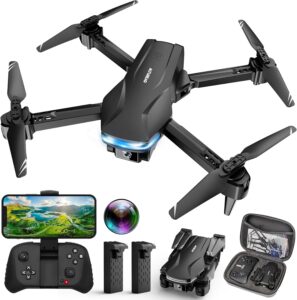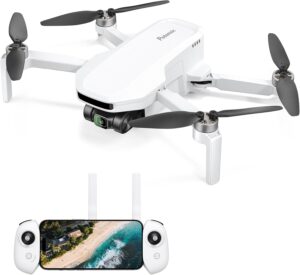Are we ready to put on a pair of goggles, give up our usual sense of dignity, and become birds for half an hour at a time?
What We Tested and Why It Stuck With Us
We spent quality time with the VTI FPV Duo Camera Racing Drone with Flight Immersive Goggles for Adults and Kids, Photo, Video, FPV drone, Easy to Use Controls, 28 Minute Flight Time. That is, admittedly, a name so long it feels like it could file its own taxes, but it tells you exactly what you’re getting. This model—also known around the box and manual as the Vivitar FPV Duo—promises a high-definition camera, first-person goggles, a generous 28-minute flight window, and beginner-friendly controls.
We wanted a drone that didn’t expect us to be engineers or daredevils and yet could make us feel like both on a Saturday morning. What surprised us is how quickly this machine shifted our living room conversations from “don’t hit the tree” to “let’s map a longer path,” which in our household is the closest thing to character growth we’ve experienced since learning to fold fitted sheets.
VTI FPV Duo Camera Racing Drone with Flight Immersive Goggles for Adults and Kids, Photo, Video, FPV drone, Easy to Use Controls, 28 Minute Flight Time
Unboxing and First Impressions
There is something disarming about cracking open a box that holds a tiny aircraft, the way it reminds us of childhood birthday presents and also our obligations as responsible, allegedly grown adults. The VTI FPV Duo comes organized and approachable, like a kindly librarian who also has a pilot’s license.
The plastic feels solid but not overly heavy. The fit of the components suggests it can handle a few rookie tumbles, which is exactly what we offered it immediately. The goggles, nestled in their own nook, look like a prop from a retro-futurist movie, and slipping them on gives an instant sense of theater. We were not immune to striking a heroic pose in the kitchen.
What’s in the Box
Inside the package, we found the drone itself, the FPV flight immersion goggles, a controller, battery, charging cables, and a set of spare propellers. The manual makes a sincere effort to be friendly and brief without assuming we speak fluent drone. We appreciated that the essentials are truly included; apart from a microSD card for saving photos and videos, we didn’t need to scramble for odds and ends.
The overall presentation is inviting. Nothing feels like it’s waiting to ambush us with hidden steps, mechanical trickery, or adult-assembly despair. We’ve set up furniture with more sorrow.
Setup: From Kitchen Table to Backyard Airstrip
Our transformation from people who admire drones to people who fly them began at the kitchen table with coffee and a sense of occasion. The VTI FPV Duo keeps setup simple enough that we didn’t need a flashlight, a magnifying glass, or the patience of a saint. It was mostly: charge, power, pair, and go outside before we tried something heroic indoors and met a lampshade with a propeller.
Charging is straightforward and mercifully uneventful. Battery seats easily, cables fit where they should, and nothing fights back. The controller links without fuss, and the goggles connect to deliver the live video feed. We were airborne faster than we expected, which is what we imagine early balloonists felt, minus the mustaches.
Pairing and Calibration
Pairing the controller and syncing the camera feed to the goggles took a few minutes and a shared glance that said, “Let’s pretend we’ve always known how to do this.” We appreciated that calibration, including gyro stabilization, is quick and required no arcane rituals. When a drone gives us more reassurance than our home Wi-Fi, we take it as a win.
The first time we saw the live feed flicker to life, it felt like discovering some hidden hatch in our daily routine. Suddenly our yard had horizons instead of boundaries. Calibration isn’t a one-time thing in the life of a drone, but it’s easy enough that we didn’t mind giving the sticks a little pre-flight checkup anytime the wind got fancy.
Safety and Prep
We adopted a three-minute ritual before every flight: check battery, check propellers, check the map for obstacles we love and don’t want to lose. The VTI FPV Duo’s auto hover makes the moment you lift off feel calm rather than chaotic, but it’s still a machine with spinning blades, and keeping a respectful distance is not a sign of fear but wisdom.
We also set a radius in our heads—well within the drone’s impressive 3,200-foot flight range—so we could build confidence early. There’s a place for random acts of bravery, and the middle of a first flight is not it. We confess that it’s nice to feel clever and cautious at the same time.
Controls and the Learning Curve
If the last video game you played involved a mushroom and a plumber, fear not. The controls on the VTI FPV Duo are designed with actual humans in mind. The left stick manages throttle and yaw, the right handles pitch and roll, and thanks to auto hover, our first moments were less about panic and more about small, triumphant adjustments.
We began by hovering a few feet off the ground, like nervous hummingbirds. Then we practiced gentle forward movement, slow turns, and careful landings. Within the first battery cycle, we felt steady enough to add a little speed and a touch of flair, though our definition of flair is basically not hitting the recycling bin.
Auto Hover and One-Touch Return
Auto hover is the gift every beginner deserves. It holds the drone stable while we gather our thoughts and pretend that we calculated that hovering spot on purpose. It makes video smoother, landings softer, and progression faster—because when the drone isn’t wobbling like a nervous chihuahua, our brains have room for ambition.
One-touch return is a safety net that doesn’t ask for applause. Press the button, and the drone heads home like a homing pigeon with a degree in logistics. We didn’t rely on it constantly, but we were grateful to have it in our back pocket whenever we felt the wind pick up or our confidence take a little nap.
For Adults and Kids
This drone suits both grown-ups and kids who can follow instructions and follow rules, though we recommend adult supervision for younger flyers. The control scheme is easy enough that our resident ten-year-old could handle hovering and gentle movement, while our older crew tried braver moves without sweating through our shirts.
The goggles make the experience a shared event. With one person flying and others sipping lemonade and watching, we took turns that felt more like passing a baton than yielding control. It’s the kind of gear that turns family time into something everyone wants to repeat, rather than a compromise born of guilt.
Our First Flights
We launched into a blue sky and didn’t immediately panic, which is a testament to the VTI FPV Duo’s calming design. The drone felt stable, the video feed was clear enough to make us gasp at ordinary things, and the controls responded smoothly even when our fingers got optimistic.
By the time we landed, we’d traced a small touring route over the yard, a patch of street, and the nearby green space. We were not ready for international reconnaissance, but we had proof we could leave the ground and return in one piece. That’s the whole contract, really.
Camera and FPV Experience
The VTI FPV Duo uses a 720p HD camera that serves as our eyes in the sky. Is it cinema-grade? No. Does it make ordinary scenes look special? Surprisingly often, yes. There’s a crispness to the feed that helps with navigation and gives our post-flight clips a warm, if slightly retro, charm.
The FPV (first-person view) goggles change the relationship between us and the world below. With the goggles on, we stop thinking of the drone as a thing we’re steering and start feeling like we’re onboard. It’s a small leap, but a meaningful one, and it makes even short flights feel like stories we get to tell.
720p HD Quality: What It Means
At 720p, we’re getting clear, detailed imagery that handles daylight well and makes horizons glow. In the crisp of early morning or late afternoon, the camera picks up enough nuance to make us feel like neighborhood poets. In low light, the quality softens—still usable, but not the place to shoot moody night operas.
For social media and casual keepsakes, 720p is perfectly fine. It’s easy on storage space and quick to share. The real magic is in the perspective: seeing our streets, fields, and roofs from above, where all the familiar parts look like new cousins visiting for the weekend.
Flight Immersion Goggles: Comfort and Clarity
The goggles fit comfortably on our collective foreheads and faces, adjusting to different head sizes without drama. The foam rests where it should. The straps grip without issuing ultimatums. And the screen gives a clean, bright view that makes us forget we’re standing next to a lawn chair.
Wearing the goggles adds a dash of theater—neighbors wave, dogs squint, and we grin—and yet the practical payoff is serious: the real-time video feed helps with framing shots and maintaining orientation. That extra confidence makes us smoother pilots and more cheerful humans.
Photos and Videos: Sharing and Saving
The included camera captures both photos and videos from the drone’s perspective. We found that simple pans and steady forward movement look the best, while rapid yaws and sudden dives (not the bird kind, the stick kind—whoops, we won’t use that word) can make footage a little jittery. Smooth moves are rewarded; showboating is not.
Sharing the results is easy and gratifying. We became the kind of people who say things like, “Wait, you have to see this angle,” and we don’t regret it. The drone turned familiar errands—walking the dog, visiting the park—into excuses for small aerial documentaries no one asked for but everyone enjoyed.
Flight Performance
We weren’t chasing medals or speed records; we wanted a drone that feels nimble but controlled, eager but polite. The VTI FPV Duo stayed steady in light to moderate breezes, and we learned to respect the wind like a fickle aunt. The frame is aerodynamic enough to help, and the stabilizers do their job like secret service agents—present but never showy.
Acceleration is quick without feeling jumpy, and turns are gentle without being dull. We felt a real sense of control, which is the difference between a pleasant afternoon and a collection of new fence dents. If there’s one image we keep returning to, it’s the drone hovering with poise, ready for the next suggestion.
Stability and Wind Handling
The auto hover and gyro stabilization are the heroes of beginner confidence. On calm days, the drone will sit almost motionless, as if listening. On breezy days, it corrects promptly, and while it won’t win a Miss Congeniality award in a gale, it handles typical backyard wind with restraint.
We learned to angle our flights to work with wind, not against it, which helps maintain battery life and keep footage smooth. It’s like learning to ride a bicycle: the bike helps, but we still steer. The drone never felt like it was running away from us, and for sanity’s sake, that matters.
Speed and Agility
The VTI FPV Duo places agility above raw speed. We could thread it through open spaces with enough zip to raise our heart rates, but not so much that we felt like we were piloting a rebellious sparrow. For a racing-labeled drone, it’s refreshingly manageable; it understands that not all of us want to turn our yards into race tracks.
As our confidence grew, so did our desire for creative routes. S-curves around trees, gentle ascents, and wide arcs over the lawn made us feel like choreographers. We suspect that’s how many people fall in love with flying—one graceful line at a time.
Range: 3,200 Feet Without Feeling Tethered
The stated flight range—3,200 feet—is a major selling point, and in clear areas, we found the signal remained steady and reassuring. That’s the difference between feeling tethered and feeling free. We still kept line of sight and respected local rules, but knowing the controller wouldn’t betray us added courage to our routes.
In city pockets with interference, we noticed a little signal hesitancy around power lines and dense structures, which is to be expected. Out in open areas, the connection felt reliable and sturdy. The distance ceiling opens the door to sweeping passes that would be impossible with shorter-range gear.
Battery Life and Charging
We will never say no to more battery, but 28 minutes is generous in this class and meaningful in practice. We could fly, film, pause, try again, and still have juice to raise eyebrows. When you’re learning, that third or fourth attempt can be the difference between frustration and a small victory, which is everything.
Charging is simple, and the battery slides in without fiddly persuasion. We recommend a second battery for longer sessions, but even with one, we didn’t feel rushed. The longest flights we did ended not with a gasp but with a satisfied sigh and a quiet landing.
Real-World 28 Minutes
The advertised 28 minutes is the ideal scenario, and our experience came close when we flew conservatively. Add wind, enthusiastic maneuvers, and generous camera use, and we were closer to the 20–25 minute range. Still, that’s a substantial window, and far better than the quick sips offered by some entry-level quadcopters.
We time our flights like we time pasta: set a gentle mental clock, trust our senses, and avoid pushing things to the edge. When the battery indicator nudges us, we listen. The last thing we want is a forced landing that introduces our shrubbery to aviation.
Battery Care Tips
We found that treating the battery like a houseplant pays dividends. Don’t leave it in extreme temperatures, don’t fully drain it to zero every time, and give it a little rest after a flight before plugging in. Store at a partial charge if it’ll be a while between sessions.
A dedicated charging spot helped us avoid cable chaos. We don’t know when we became those people, but having a “drone shelf” turned us into gently smug organizers, which is its own quiet joy.
Reliability and Signal Confidence
The VTI FPV Duo gave us a stable connection with minimal fuss. We noticed a small signal dip near clusters of wires, as one does, but range and feed recovered quickly. The video felt smooth enough that the goggles never made us queasy, which is a relief for anyone who doesn’t want flight time to double as a test of stomach bravery.
We also want to mention that the drone responded predictably to every command. There’s a kind of calm you get when your machine acts like a good listener. Even when we made clumsy moves, the drone did its best to interpret them politely.
Fail-Safes That Build Trust
The combination of auto hover and one-touch return makes this drone feel like a friend who won’t abandon us when we misjudge a turn. We leaned on these features at the end of flights, especially when we were savoring the last few minutes and forgot to watch the battery closely.
We tested a few higher-than-usual ascents and found that the stabilizers kick in to keep the craft from drifting too far or yawing unnecessarily. A drone that behaves makes us bolder in small, careful steps, which is the only kind of boldness we can enjoy on a Tuesday.
Who This Drone Fits
We believe this drone is best for curious adults, patient beginners, and families who like toys with a touch of theater. It’s capable enough to hold our attention and forgiving enough to keep the mood light. It’s less about record-breaking tricks and more about the pleasure of seeing the world from several stories up.
If you’ve never flown before, it feels like a well-padded entry point. If you’ve flown something cheap and twitchy that left you anxious, this will feel like a correction, a return to sanity. And if you’re a casual enthusiast who wants to share the fun, the goggles turn the pastime into an event.
Beginners Who Want a Real Start
This is the drone we wish we’d had at our first awkward lessons, the one that would have prevented certain misunderstandings with a garden gnome. The combination of auto hover, straightforward controls, and one-touch return is a perfect trio for consciousness-raising.
We also like that the goggles reward even the most basic flight with intensity. Hovering is suddenly fascinating when you’re “inside” the craft. That delight helps beginners stick with it through the inevitable early bumps.
Hobbyists and Casually Competitive Flyers
If you think of yourself as the person who brings the fun to picnics and gets credit for effort, the VTI FPV Duo will make you look good. It won’t beat specialized racers in speed, but it offers a more even temperament, which many of us prefer. There’s plenty of zip for obstacle courses made of pool noodles and bravado.
We had zero trouble staging repeatable routes and comparing times. The drone’s predictability makes that possible—smooth acceleration, steady turns, and enough range to stretch our creativity without worrying about going out of bounds.
Families and Shared Hangouts
Passing the controller—and the goggles—around felt like we were hosting a small festival with a dress code of enthusiasm. Everyone watched, commented, and took turns, which is a small miracle in the age of individual screens. It’s proof that good gadgets create shared rooms, even if those rooms are temporarily ten feet in the air.
With kids, we found it helpful to set simple rules: keep line of sight, stay below treetops, and no flying over crowds or roads. The drone cooperates with this approach because it isn’t constantly begging us to prove something.
Pros and Cons
We like to be clear-eyed about our gear. Here’s what made us cheer and what made us nod thoughtfully and adjust expectations.
We hope this helps you decide whether the VTI FPV Duo fits your needs, your yard, and your tolerance for becoming locally famous among your neighbors.
- Pros:
- First-person goggles make each flight feel cinematic and immediate.
- Auto hover and one-touch return keep stress low and confidence high.
- Up to 28 minutes of flight time means more practicing and better footage.
- 3,200-foot range reduces anxiety about hitting invisible walls.
- 720p camera offers crisp, bright daytime images that are easy to share.
- Controls are accessible to beginners yet responsive enough for playful stunts.
- Build feels sturdy, with spare props included for the early hiccups.
- Cons:
- 720p is not for pixel chasers; serious filmmakers will want higher resolution.
- Windier days ask for finesse, as is typical for lightweight quads.
- Low-light footage softens; this is a daylight performer first.
- One battery in the box means charging breaks unless you buy a spare.
Specs and Experience at a Glance
We assembled the details that mattered to us most in a simple table. Think of it as a quick reference for the parts of the relationship that we kept returning to.
| Feature | What It Means | Our Take |
|---|---|---|
| Camera | 720p HD photo and video | Clear and bright in daylight; ideal for social sharing and FPV navigation. |
| FPV Goggles | Live first-person feed | Comfortably immersive; boosts confidence and storytelling. |
| Flight Time | Up to 28 minutes | Real-world 20–28 minutes depending on wind and flying style; generous for the class. |
| Flight Range | Up to 3,200 feet | Frees us from feeling restricted; keep line of sight and local rules in mind. |
| Controls | Beginner-friendly with auto hover | Calm and predictable; a great teacher for new pilots. |
| Return Feature | One-touch return | A reliable safety net during early learning and windy moments. |
| Stability | Gyro stabilization | Hovering feels poised; footage benefits from the steadiness. |
| Build | Lightweight, sturdy plastic | Handles typical bumps; spare props are a thoughtful inclusion. |
| Ease of Setup | Charge, pair, calibrate | Straightforward; we were airborne quickly without drama. |
| Use Case | Adults and kids (with supervision) | Great for families and casual pilots who want shared fun and easy wins. |
| Video Storage | MicroSD card (not always included) | Grab a quality card to save clips; transfer and share afterward. |
| Best Conditions | Daylight, light wind | A daytime star; low light is serviceable but not its strong suit. |
| Learning Curve | Gentle | Early mastery leads to genuinely fun, creative flights. |
| Value | High for features | Goggles plus long battery time create standout bang for the buck. |
This summary captures the essentials so we don’t lose forest for trees, or drone for shrubbery. When we look back at our notes, these are the reasons we kept going outside with a grin.
Comparisons and Value
We’ve flown our share of budget quadcopters that promise the world and then treat the sky like a rumor. The VTI FPV Duo sits in a more serious sweet spot: the camera is plainly 720p rather than something fancy, but the goggles and battery life combine to create a premium-feeling experience without a premium headache.
Some models in this range advertise higher resolution but cut corners on flight time or stability, which makes for pretty pictures and short sessions. Others push speed without giving beginners the lifelines that keep the fun going. This drone doesn’t posture; it balances its priorities in a way that made us stay out a little longer every weekend.
It’s hard to overstate how much the goggles add to perceived value. Without them, you’re squinting at a phone screen and pretending you’re not getting texts. With them, you’re in the chair. That difference alone turned hesitant relatives into braver pilots, which is priceless if your reunions need a new favorite activity.
Tips, Tricks, and Best Practices
Small habits make big differences in the sky. We wrote these down for ourselves, and now we pass them on like a neighbor who’s learned the hard way which plants are deer candy.
These tips aim to help you get smoother footage, better range, and a calm heartbeat. Whether you’re new or just brushing up, your future self will thank you.
Getting Smoother Footage
We learned to feather the sticks rather than jab them. Slow inputs create fluid lines that look impressive on a second viewing, whereas sudden jerks tend to produce videos that resemble nervous confessions. Think of your hands as librarians.
Plan a shot before you move. If we wanted to circle a tree, we set the distance, took a breath, and began gently. The drone rewards intention, and your clips will look like they understand choreography.
Extending Range Responsibly
We keep the antenna oriented properly, like a small ritual. When in doubt, climb a bit for better line of sight, but not so much that we pretend to be air traffic control. Open spaces are friends; dense cities will test your confidence.
Remember that range isn’t just distance—battery and wind count, too. We always budget return time into our flights; no souvenir is worth a lonely drone.
Indoor vs. Outdoor Choices
Yes, it can lift indoors, but unless you live in a gymnasium or a warehouse, we strongly recommend keeping flights outdoors. Living rooms have a way of sprouting hazards, and our nerves prefer the forgiving space of a yard or field.
If you must practice inside, choose a defense-free zone: soft carpets, no fans, no pets, and absolutely no chandeliers. Brace your ego accordingly.
Maintenance and Durability
Like any good relationship, this one gains a lot from consistently low-key attention. We checked propellers before each flight, wiped off dust after, and stored the drone somewhere it wouldn’t be sat on by a chair that forgot its manners.
Durability felt respectable for the weight. The frame absorbed a few no-drama bumps, which we appreciated. And when we nicked a propeller, we were grateful for the spares because going from “we were learning” to “we are grounded” is a mood we reject.
Parts and Replacements
Propeller swaps are painless once you’ve done one. We kept a small kit handy with a screwdriver, extra props, and a magnanimous attitude. This preparedness turns mishaps into five-minute intermissions.
If you plan to fly often, consider adding a second battery to your kit. You’ll spend more time writing the stories and less time waiting for them to happen. Also, a protective case keeps the drone from developing mysterious scratches from shelf gremlins.
Cleaning and Storage
We used a soft brush to clear dust from vents and motors, and a microfiber cloth for the camera lens. You’ll be amazed at how much a speck can announce itself on video. Treat the lens like a friend’s reading glasses.
Storage is simple: cool, dry place, away from direct sunlight and the great toy avalanche. We learned the hard way that leaning it at the edge of a shelf is basically an invitation for gravity to perform a demonstration.
Safety, Legal, and Etiquette
We’re not your parents (some of us are our own parents, but that’s a different story), yet we care about keeping the experience civil and free of apologies. Know your local rules, respect privacy, and keep line of sight so your drone doesn’t wander into unintended friendships with telephone poles.
We also learned to steer clear of crowded areas, roads, and anything official-looking with a badge, a whistle, or a rotating radar. As a rule, if a place feels like it belongs to someone who takes notes for a living, go somewhere else.
Courtesy in the Air
When neighbors noticed the drone, we explained what we were filming and kept the camera angled away from windows and people. It’s the aerial equivalent of not reading over someone’s shoulder on a train. A friendly wave goes a long way.
We also kept our flights short near parks where others are present, and we avoided buzzing anyone who didn’t ask to be buzzed. The sky is big enough for kindness.
Customer Support and Warranty
While we didn’t need to open a support ticket, the included documentation was clear on setup and safety, and the brand’s presence across the materials felt reassuring. We keep packaging and receipts together because our future selves deserve such luxuries.
If you do need help, having your serial number, purchase info, and a calm description of what went wrong makes any conversation go smoother. The drone itself inspires that kind of calm; we found it hard to be grumpy around a gadget that spends its time defying gravity.
Moments That Sold Us
It wasn’t one big stunt that converted us, but a handful of small human moments. The first was our group’s inaugural hover, when all of us fell silent as the craft hung in place like an obedient star. The second was a slow, steady pass over a row of maple trees that made the afternoon look like something we could keep.
Then there was the laughter when the goggles came off and we realized we’d been standing with our mouths open. The drone gave us a new ritual: step outside, check the wind, make the ordinary feel like an event. We didn’t know we needed that until we had it.
What We’d Love to See Next Time
No product is a poem and that’s fine, but we keep a polite wishlist in our pockets. A bump to 1080p would please the pixel-faithful, especially for those who like to crop their footage. A bundled second battery would turn good afternoons into great ones without opening our wallets immediately.
That said, we wouldn’t trade away the stability or the flight time for spec sheet glory. The balance here is what makes the drone so agreeable. We’d rather have thirty minutes of calm competence than a power-hungry camera that cuts the party short.
The Experience of the Goggles
We expected the goggles to be a novelty, but they became the center of gravity for our flights. There’s a tactile sense of presence when you’re looking through that screen that turns even a short arc into a narrative. While one of us flew, others watched, took turns, and offered wildly helpful commentary like “Up!” and “Less fence!”
Comfort matters, and the goggle fit never pushed us into headache territory. We suspect your mileage may vary, as faces do, but for our mix of noggins the straps settled in easily. And we discovered an unexpected benefit: with the goggles on, we were less likely to get distracted by our phones, because the world in front of our eyes was more interesting.
The Romance of 3,200 Feet
Range is more than a spec; it’s a permission slip. We didn’t spend our first week staking out the far limits like intrepid explorers (we refuse to use that word), but we loved knowing the controller could hang on as we expanded our routes. There’s a middle ground between “right here” and “where did it go,” and this drone lives there comfortably.
We found ourselves tracing bigger shapes over time: a loop around the block’s edges, a pass over open fields, a return at a height that made the trees look like broccoli. As long as we kept smart eyes on the surroundings and respected the rules, it felt liberating.
Weather and Seasonal Notes
Like a cat, this drone likes the sun and tolerates a breeze. Warm days with gentle air are where it shines, producing smooth video and cooperative handling. In gusty conditions, we kept our flights shorter and lower, which still yielded good practice and decent footage if we chose our angles.
Cold weather will affect battery life—as it does to all lithium packs—so we kept our flights shorter and kept the battery warm until just before launch. Snow-covered scenes look delightful from above, but frostbitten fingers make for messy inputs, so gloves are not a bad idea.
Teaching Others with the VTI FPV Duo
Passing along what we learned felt natural with this drone. We gave new pilots three stages: hover, circle, return. Now and then we tossed in a “let’s go straighter than last time,” which produced a lot of giggles and one moderate apology to a bush.
The goggles served as an excellent teaching tool. Letting a new pilot see exactly what the drone sees speeds up understanding, and handing over the controller only when they’ve observed the moves gives them confidence. It’s like letting someone read your mind, assuming your mind is currently steering a small aircraft.
If You’re Coming from Toy Drones
If you’ve flown those tiny indoor quads that weigh less than a sandwich and careen like caffeinated moths, this will feel like a promotion. The VTI FPV Duo actually listens. It holds position, respects your will, and delivers images that don’t look like witness protection footage.
You’ll quickly learn that small, smooth inputs work better than frantic joystick gymnastics. You’ll also notice that not every gust needs a counter-move; the stabilization will meet you halfway. The relief of not fighting your gear is a subtle, lifelong thrill.
If You’re Camera-First
If your primary itch is cinematic footage, you’ll appreciate the drone’s steadiness, but you’ll want to manage expectations on resolution. We found the 720p camera totally adequate for a highlight reel, travel snippets, and social posts. Gentle, planned movements and good light yield the best results.
We also recommend shooting during golden hours—morning or late afternoon—when colors come alive and shadows paint texture. The drone’s calm handling lets you focus on composition without wrestling with stability.
The Little Things We Liked
We love that the controller fits naturally in hand, that the battery clicks with confidence, and that the spare propellers are included like the manufacturer knows us personally. We love that the manual didn’t try to be cute and instead stayed serviceable and kind.
Most of all we love the feeling that we’re allowed to be beginners without apology. The drone meets us as we are and nudges us gently toward better habits. That’s all we ask from gadgets and people.
Verdict: A Friendly Pilot’s First Real Companion
We came for the goggles and stayed for the equilibrium. The VTI FPV Duo Camera Racing Drone with Flight Immersive Goggles for Adults and Kids, Photo, Video, FPV drone, Easy to Use Controls, 28 Minute Flight Time is the rare machine that makes novices feel welcomed and returns something charming to veterans: the uncomplicated joy of flight.
The combination of a 720p camera, first-person goggles, a long battery window, and beginner-smart features adds up to a package that’s easy to recommend. It won’t turn you into a cinematographer overnight, and it won’t ask you to pretend you’re a stunt pilot. It will take you outside, point you upward, and make your ordinary places feel like secrets worth visiting.
Should You Buy It?
If you want a straightforward, confidence-building FPV drone that favors long, satisfying sessions over spec-sheet fireworks, yes—this belongs on your shortlist. If you need more resolution than 720p can give, fair enough, but you’ll be trading away battery time or ease of use in many cases.
We’re keeping ours, and not just because the goggles make us look dramatic in the best possible way. We’re keeping it because it turned a patch of sky into a place we can visit together, one smooth arc at a time.
Disclosure: As an Amazon Associate, I earn from qualifying purchases.
